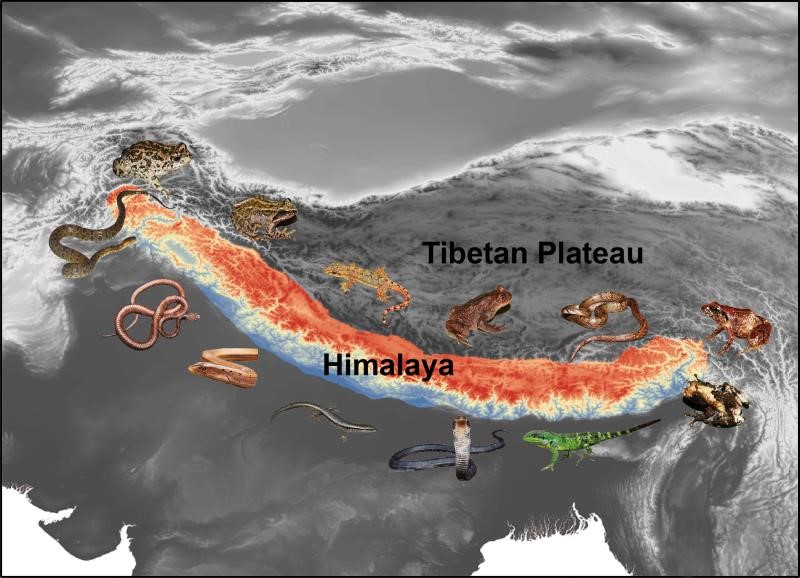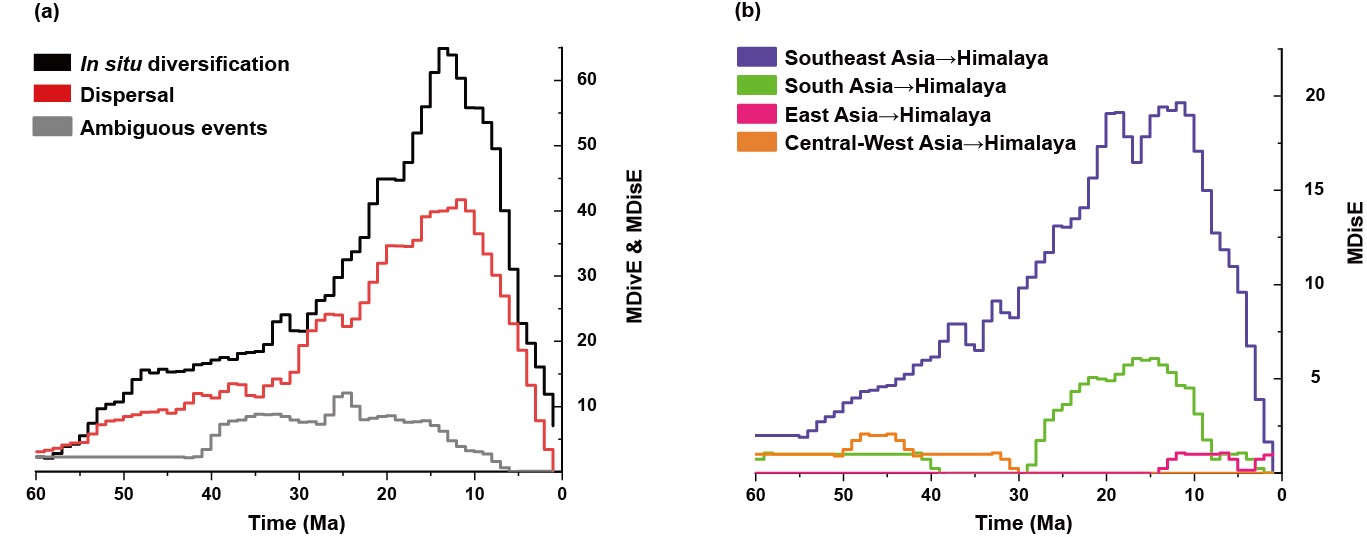The Himalaya are among the youngest and highest mountains in the world, but the exact timing of their uplift and origins of their biodiversity are still in debate. Generally, there are two hypotheses about the uplift process of the Himalaya. A “Stepwise Hypothesis” was proposed recently, which suggested that the Himalaya rose slowly from 1,000–2,500 m during the period of 56–23 Ma (million years ago, Ma), with an additional rapid period of elevational increase to 4,000 m from 23–19 Ma, and a final rise around 15 Ma to the current average elevations of about 5,000 m. Alternatively, “Late Orogeny Hypothesis” was supported by recent hydrological and thermal evidences that this region was probably not elevated to current elevation till mid-Pliocene.
Time-based records of biological processes can be informative about montane histories and environmental changes. Various hypotheses about Himalayan origins can be tested using phylogenetic information and estimates of the timing of biological speciation events. The Himalayan region encompasses multiple countries and has many access challenges, so sampling across the entire region is difficult, which has inhibited integrative studies of the origin of the Himalayan biota. To address the question about the timing of the Himalaya uplift, a research team led by Prof. CHE Jing from Kunming Institute of Zoology of the Chinese Academy of Sciences, collaborating with Prof. David M. Hillis from University of Texas at Austin, carried out field work across the Himalaya to collect samples of amphibians and reptiles.
With relatively low dispersal ability, amphibians and reptiles (the frogs, lizards and snakes informally) are ideal organisms for studying biogeographic relationships and they generally retain high-resolution signals of historical responses to environmental changes. They are often used to test geological and climate hypotheses.
A total of 14 independent time-calibrated phylogenies of Himalayan-associated amphibian and reptile families involving 85 genera and 1,628 species (Frogs: Ranidae, Rhacophoridae, Dicroglossidae, Ceratobatrachidae, Bufonidae, Megophryidae; Lizards: Agamidae, Anguidae, Gekkonidae, Scincidae; Snakes: Pareidae, Colubridae, Elapidae and Viperidae) was reconstructed. Among these, they estimated times of divergence among 183 species that occur in the Himalaya. The biogeographic history was reconstructed for these groups. Combining 14 time-calibrated phylogenies of Himalayan-associated amphibian and reptile families, they conclude that the origins of the Himalayan herpetofauna date to the early Paleocene, but that diversification of most groups was concentrated in the Miocene. Both the in situ diversification rate, as well as the dispersal rate into the Himalaya, fit the Stepwise Hypothesis for the origin of this mountain range. In contrast, their results are inconsistent with the Late Orogeny Hypothesis for Himalayan origins.
The rapid Himalayan uplift and associated intensified South Asia Monsoon not only promoted a pulse of uplift-driven in situ diversification, but also affected the rates of biotic interchange. Biotic interchange was restricted by the lack of a moist environment that is required by many reptiles and amphibians. In contrast, an expanded tropical forest belt is thought to have persisted between the Himalaya and Southeast Asia since the middle Miocene, which likely accounts for the high dispersal rates between these two regions.
This work has important implications about the assembly process of Himalayan herpetofauna. Their analyses show a deep-rooted origin of Himalayan herpetofauna originating in the Paleocene, but with rapid diversification in the Miocene. The study, entitled “Herpetological phylogeographic analyses support a Miocene focal point of Himalayan uplift and biological diversification”, was published in National Science Review on October 21,2020. Web link: https://academic.oup.com/nsr/advance-article/doi/10.1093/nsr/nwaa263/5934401# . XU Wei is the first author, Dr. CHE Jing and Dr. David M. Hillis are corresponding authors in this paper. This study was financially supported by the Second Tibetan Plateau Scientific Expedition and Research (STEP) program (2019QZKK0501), Strategic Priority Research Program of the Chinese Academy of Sciences (CAS) (XDA20050201), the Youth Innovation Promotion Association CAS, and the Animal Branch of the Germplasm Bank of Wild Species of CAS (the Large Research Infrastructure Funding), the CAS Scholarship of [(2018) 8] to Che Jing; CAS President’s International Fellowship Initiative (2018VBA0039) to David M. Hillis.

The Himalaya and representative amphibians and reptiles
(Image drawn by LU Chenqi and XU wei, copyright preserved)

Biotic assembly through time of herpetofauna in the Himalaya.
(Image from this study, copyright preserved) |
(By XU Wei; Editor: YANG Yingrun)
Contact:
YANG Yingrun
E-mail:yangyingrun@mail.kiz.ac.cn
Kunming Institute of Zoology .CAS
